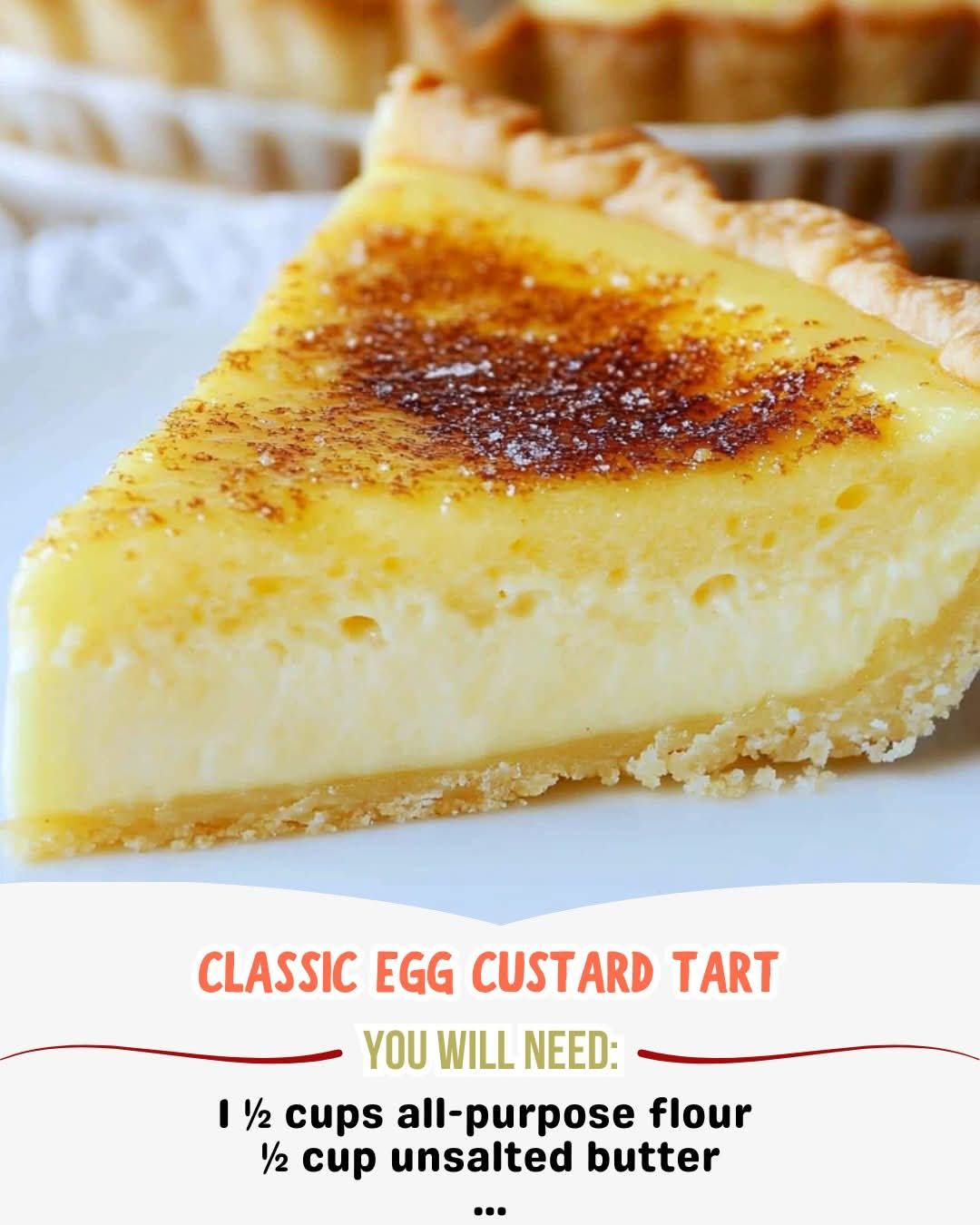Sure! Here’s a comprehensive, detailed, and lovingly crafted recipe for the Classic Egg Custard Tart, complete with its history, ingredients, preparation method, and cultural significance. Let’s dive in!
🥚 Classic Egg Custard Tart Recipe 🥧
A timeless dessert rich in history and flavor, adored by generations across the globe.
📜 Introduction
The Egg Custard Tart is a golden treasure in the world of baking — a crisp, buttery pastry shell filled with a silky-smooth, lightly sweetened egg custard, gently baked until just set. It’s a dessert that transcends time, geography, and culture — from the grand dining tables of medieval Europe to the humble bakeries of Macau and dim sum carts of Hong Kong. Simple yet sophisticated, this tart is a true expression of the magic that happens when you mix eggs, milk, sugar, and flour with a little care and love.
🕰️ A Brief History
The custard tart dates back to medieval England, where it was known as a “doucet” or “doucetty.” The early versions included spices like saffron and were made for the aristocracy. In Portugal, it became known as “Pastel de Nata,” a beloved national treat born in the monasteries of Lisbon. The concept traveled across the seas and evolved into the Macanese egg tart, with a caramelized top and flaky puff pastry crust.
In the UK, the classic egg custard tart is often dusted with a touch of nutmeg — a nostalgic dessert found in school dinners and teatime tables. It remains a favorite among lovers of traditional baking.
🧡 Ingredients
🥧 For the Sweet Shortcrust Pastry:
- 1 ½ cups (190g) all-purpose flour
- ½ cup (115g) unsalted butter, softened
- ¼ cup (50g) granulated sugar
- 1 large egg yolk
- 2–4 tablespoons cold water
🍮 For the Custard Filling:
- 2 cups (480ml) whole milk
- ½ cup (100g) granulated sugar
- 4 large eggs
- 1 teaspoon pure vanilla extract
- Freshly grated nutmeg (optional, but traditional)
🛠️ Equipment Needed
- 9-inch tart tin or 6–8 mini tart pans
- Mixing bowls
- Rolling pin
- Saucepan
- Whisk
- Fine sieve
👩🍳 Method
STEP 1: Make the Pastry
- In a mixing bowl, combine the flour and sugar. Rub in the butter using your fingers or a pastry cutter until the mixture resembles breadcrumbs.
- Add the egg yolk and 2 tablespoons of cold water. Mix until the dough just comes together — add more water, a teaspoon at a time, if needed.
- Shape the dough into a disc, wrap in plastic wrap, and chill for at least 30 minutes.
STEP 2: Prepare the Custard
- In a saucepan, gently heat the milk until just below boiling point. Do not let it boil.
- In a separate bowl, whisk the eggs, sugar, and vanilla extract until combined but not frothy.
- Slowly pour the warm milk into the egg mixture, whisking constantly.
- Strain the custard through a fine sieve to ensure a silky texture.
STEP 3: Assemble the Tart
- Preheat the oven to 350°F (175°C).
- Roll out the chilled pastry on a floured surface and line your tart tin. Trim the edges.
- Prick the base with a fork. Line with parchment paper and fill with baking beans. Blind bake for 15 minutes.
- Remove the beans and bake for another 5 minutes until lightly golden.
- Pour the strained custard into the tart shell. Grate a little nutmeg on top.
STEP 4: Bake the Tart
- Carefully place the filled tart into the oven and bake for 25–30 minutes, or until the custard is just set with a slight wobble in the center.
- Allow to cool completely before removing from the tin.
💡 Tips & Tricks
- Don’t overbake the custard — it should be soft and creamy, not rubbery.
- You can flavor the milk with a strip of lemon peel or a cinnamon stick while heating for an aromatic twist.
- Serve chilled or at room temperature, with a dollop of whipped cream or fresh berries.
❤️ For the Lovers of Egg Custard Tart…
Egg Custard Tart lovers are a unique breed: nostalgic, romantic, and often quietly devoted to comfort foods. They understand the elegance in simplicity. Whether it reminds them of their grandmother’s baking, their favorite corner bakery, or a street stall in Macau, this dessert connects us to memory, culture, and emotion. Lovers of egg custard tarts know that it’s not just a dessert — it’s a warm hug in a pastry shell.
🔄 Formation & Cultural Variations
The egg custard tart has found new life in different parts of the world:
- Macau/Portugal: Flaky puff pastry, caramelized top, known as “Pastel de Nata.”
- Hong Kong: Sweeter, brighter yellow, often seen in dim sum restaurants.
- England: Nutmeg-dusted, creamy, served at tea time.
- France: Appears as “Flan Pâtissier,” with a firmer, vanilla-scented custard.
Each version tells a story — of colonial influence, trade routes, adaptation, and local preference. They all share the same heart: egg, sugar, milk, and love.
🏁 Conclusion
The Classic Egg Custard Tart is more than a recipe — it’s a bridge between generations, cultures, and kitchens. Its golden glow is a testament to the power of humble ingredients transformed by technique and care. Whether enjoyed with tea on a rainy afternoon or as a special treat after dinner, it’s a dessert that speaks directly to the soul.
Would you like a printable version, a simplified one for beginners, or a twist like a coconut or pandan custard version?
